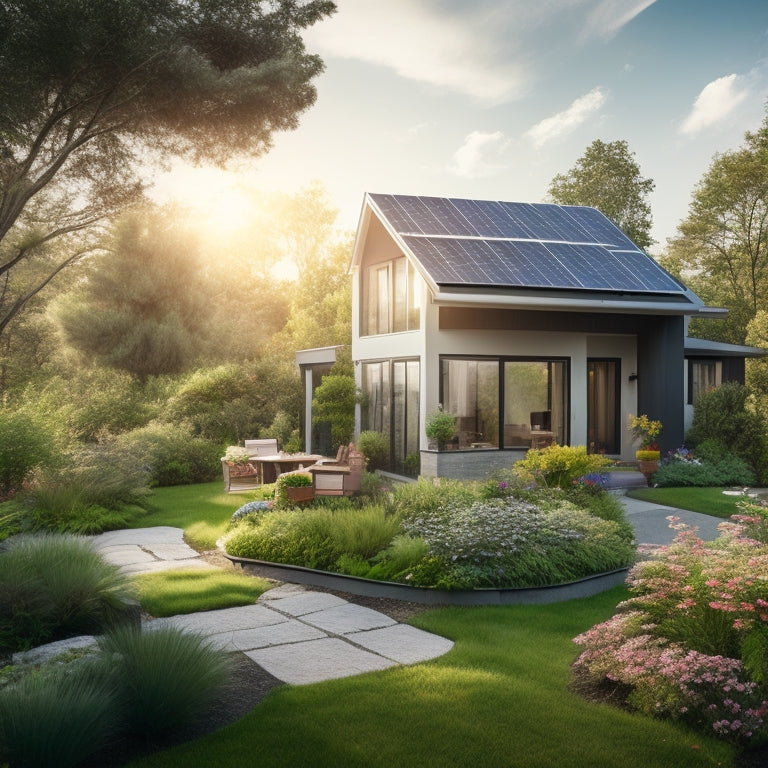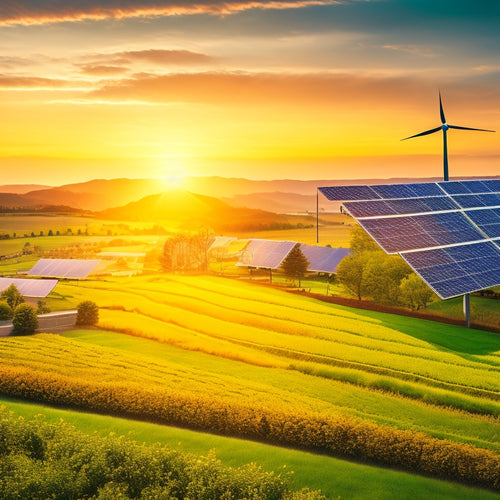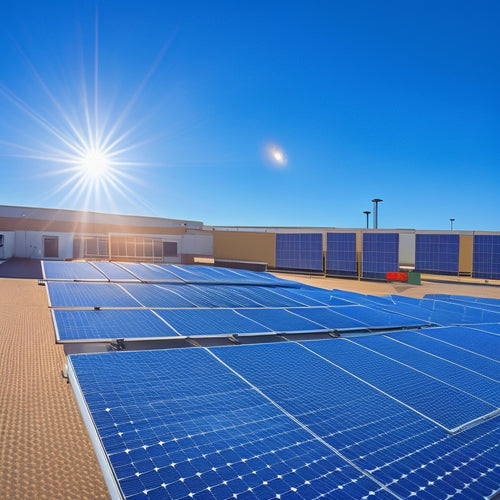
Maximize Home Energy Independence With Simple Hacks
Share
You're taking control of your home's energy usage, and with a few simple hacks, you can maximize your energy independence, reduce your reliance on the grid, and save money on your utility bills. Start by monitoring your energy consumption through smart plugs or energy trackers, and conduct regular energy audits to identify waste. Optimize your energy use by sealing air leaks, upgrading to energy-efficient appliances, and adjusting thermostat settings. Consider integrating smart home automation and renewable energy solutions, like solar panels, to reduce your energy consumption. By implementing these hacks, you'll be well on your way to maximizing your home's energy independence - and there's even more to uncover.
Overview
- Conduct regular energy audits to identify inefficiencies and optimize energy use through simple fixes like sealing air leaks and upgrading to energy-efficient appliances.
- Invest in smart plugs or energy monitors to track energy consumption patterns and identify waste, reducing reliance on the grid through smart home automation.
- Implement nighttime habits to turn off unused devices and adjust thermostat settings for less energy use while sleeping to minimize energy waste.
- Utilize renewable energy solutions like solar panels or wind turbines to generate energy and reduce reliance on the grid for maximum energy independence.
- Focus on reducing heat gain in summer and loss in winter through energy-efficient improvements like insulation, windows, and doors to minimize energy consumption.
Monitor Your Energy Consumption
As you commence on the expedition to home energy independence, it's vital to understand where your energy is being consumed. You can't manage what you don't measure, so energy tracking is essential.
Conducting energy audits, as outlined in energy needs assessment, can help identify inefficiencies and improvement opportunities. Start by reviewing your past utility bills to identify consumption patterns. Are there any seasonal spikes or consistent drains on your energy resources?
Next, consider investing in a smart plug or energy monitor to provide real-time data on your energy usage. This will help you pinpoint areas of inefficiency and make informed decisions about where to focus your energy-saving efforts.
Optimize Your Home's Energy Use
You've got a good handle on your energy consumption, now it's time to optimize your home's energy use. By reducing energy waste and implementing smart home automation, you can make your home more efficient and reduce your reliance on the grid.
Conducting a thorough load profiling analysis load profiling analysis can help you identify areas where energy is being wasted and implementing simple fixes, like sealing air leaks and upgrading to energy-efficient appliances.
Start by identifying areas where energy is being wasted and implementing simple fixes, like sealing air leaks and upgrading to energy-efficient appliances.
Reduce Energy Waste
One essential step towards home energy independence is reducing energy waste, which can account for up to 30% of your total energy consumption.
You're probably wondering where it all goes. Well, it's often due to inefficient systems and outdated appliances. Start by replacing traditional incandescent bulbs with LEDs, which use considerably less energy.
Next, upgrade to energy-efficient appliances, like those with the ENERGY STAR label. grid-tie systems can also enable clean energy generation and excess energy sales to the grid, further reducing energy waste.
Additionally, considering affordable renewable energy options, such as solar power, can reduce carbon footprints and decrease fossil fuel dependence.
Insulation improvements can also make a huge difference, as heat can escape through poorly insulated walls, floors, and ceilings.
Smart Home Automation
Now that you've addressed the energy-wasting culprits in your home, it's time to take your energy independence to the next level by optimizing your home's energy use through smart home automation.
By integrating energy-efficient appliances, automated lighting solutions, and smart thermostats, you can considerably reduce your energy consumption.
Remote monitoring systems and energy management apps allow you to track your energy usage in real-time, receiving alerts when you're using too much energy.
Voice-activated controls and smart plugs make it easy to turn off appliances when not in use.
Program programmable schedules to optimize energy use based on your daily routine.
With home integration systems, you can control all your devices from one central hub.
Harness Solar Power Efficiently
You'll get the most out of your solar panels by optimizing their orientation, which can increase energy output by up to 40%.
By facing them directly at the sun and adjusting for seasonal changes, you'll maximize your energy harvest.
Now, let's investigate how to reduce energy loss and optimize energy output to achieve true home energy independence.
Solar Panel Orientation
By optimizing solar panel orientation, you can greatly enhance the energy output of your solar panel system.
The ideal solar panel tilt and placement vary depending on your location and the time of year. In the northern hemisphere, a south-facing orientation is best, while in the southern hemisphere, a north-facing orientation is ideal.
The tilt of your solar panels should be equal to your latitude, adjusted for seasonal variations. For example, if you live at a latitude of 35°, your solar panel tilt should be around 35° during the summer and 55° during the winter.
Proper solar panel placement can also reduce shading from trees, buildings, and other obstructions, ensuring maximum energy output.
Optimize Energy Output
Maximizing energy output from your solar panel system requires more than just proper orientation - it demands a strategic approach to utilizing solar power efficiently.
You need to focus on energy efficiency and output management to get the most out of your system. Start by monitoring your energy production and consumption patterns to identify areas of improvement.
Adjust your energy usage habits to match your solar panel's energy output, using more energy during the day when the sun is shining. You can also invest in energy storage systems like batteries to store excess energy for later use.
Reduce Energy Loss
As you work for home energy independence, utilizing solar power efficiently becomes essential to minimize energy loss. To achieve this, focus on reducing heat gain during summer and heat loss during winter.
| Energy Loss Reduction Strategies | Benefits |
|---|---|
| Insulation improvements | Reduces heat loss by up to 30% |
| Draft sealing | Eliminates heat escape through gaps and cracks |
| Energy-efficient windows | Minimizes heat transfer and reduces energy loss |
| Proper home orientation | Optimizes natural light and heat from the sun |
Reduce Energy Waste Overnight
Five simple tweaks to your daily routine can greatly reduce energy waste overnight.
Start by developing good nighttime habits, such as turning off lights, TVs, and computers when not in use.
Make it a habit to unplug chargers, toasters, and other appliances when not in use, as they continue to draw power even when turned off.
Replace traditional incandescent bulbs with energy-efficient LED bulbs, which use considerably less energy.
Upgrade to energy-efficient appliances, such as LED TVs and Energy Star-rated refrigerators, to reduce standby power consumption.
Finally, adjust your thermostat to use less energy for heating and cooling when you're asleep.
Smart Home Devices for Savings
Efficiency converges with innovation in the domain of smart home devices, designed to optimize your energy consumption and put money back in your pocket.
You can take control of your energy usage with smart thermostats that learn your schedule and preferences to adjust the temperature accordingly. They can also be controlled remotely, ensuring you don't waste energy when you're not home.
Another way to save is by installing energy-efficient lighting, such as LED bulbs, which use considerably less energy than traditional incandescent bulbs. Smart lighting systems can also be programmed to turn off when not in use, eliminating standby power consumption.
DIY Energy Audits Made Easy
Conducting a DIY energy audit is an essential step towards identifying areas of energy inefficiency in your home, and it's easier than you think.
You can start by creating an energy audit checklist to guide you through the process. Begin by inspecting your home's insulation, looking for gaps and cracks that allow heat to escape. Check your attic, walls, and floors for adequate insulation, and consider adding more if necessary.
Follow home insulation tips like sealing air leaks and adding insulation to your water heater and pipes.
Next, examine your windows and doors for energy efficiency, and consider replacing them if they're old or inefficient.
Frequently Asked Questions
Can I Install Solar Panels on My Roof if It's Not Facing South?
You can install solar panels on a non-south-facing roof, but you'll need to evaluate solar panel orientation and potential roof shading to optimize energy output; a professional assessment will help determine the best configuration for your specific situation.
How Often Should I Replace My Air Filters to Maximize Efficiency?
You should replace your air filters every 1-3 months, depending on filter types and seasonal changes, to maximize efficiency and improve indoor air quality, ensuring your HVAC system runs smoothly and reduces energy waste.
Are Smart Home Devices Compatible With My Old Appliances?
You're probably surrounded by a dinosaur herd of old appliances, but don't worry, you can tame them with smart plugs that bridge the gap, making appliance upgrades a breeze, and freeing you from energy dependence!
Can I Really Save Money by Using Power Strips to Plug in Electronics?
You can cut energy waste by using power strips to plug in electronics, eliminating "energy vampires" that drain power even when turned off, and reap the power strip benefits of saving up to $100 annually on your utility bills.
Do Energy-Efficient Appliances Require Special Maintenance?
You won't need to worry about special maintenance for energy-efficient appliances, but following energy saving tips like cleaning filters and checking seals can actually extend an appliance's lifespan, saving you time and money in the long run.
Ready to Buy
By implementing these simple hacks, you'll be well on your way to maximizing home energy independence. It's like having a superpower - you'll be in control of your energy usage, saving money and the planet at the same time. With a few tweaks and adjustments, you can break free from the grid and bask in the satisfaction of self-sufficiency. Your wallet and the environment will thank you.
Related Posts
-

Net Metering in Renewable Energy's Future
Net metering's future is vital for driving renewable energy growth and financial savings. You can reduce your electri...
-

Solar Phone Chargers for Camping Essentials
Solar phone chargers are must-haves for your camping essentials, allowing you to stay connected while enjoying nature...
-

Essential Solar Panel Mounts for Commercial Properties
When it comes to essential solar panel mounts for your commercial property, durability and wind resistance are key fa...


